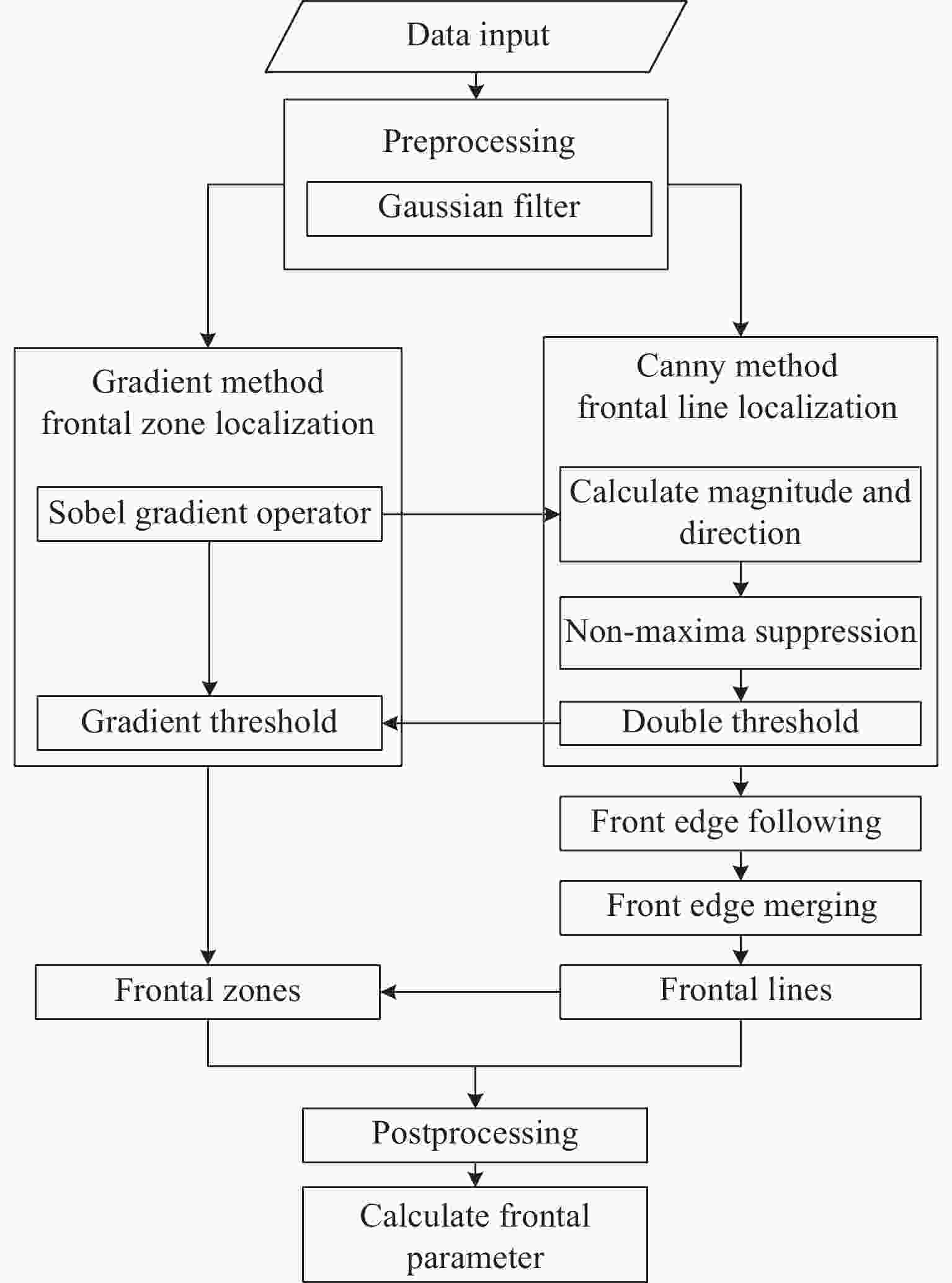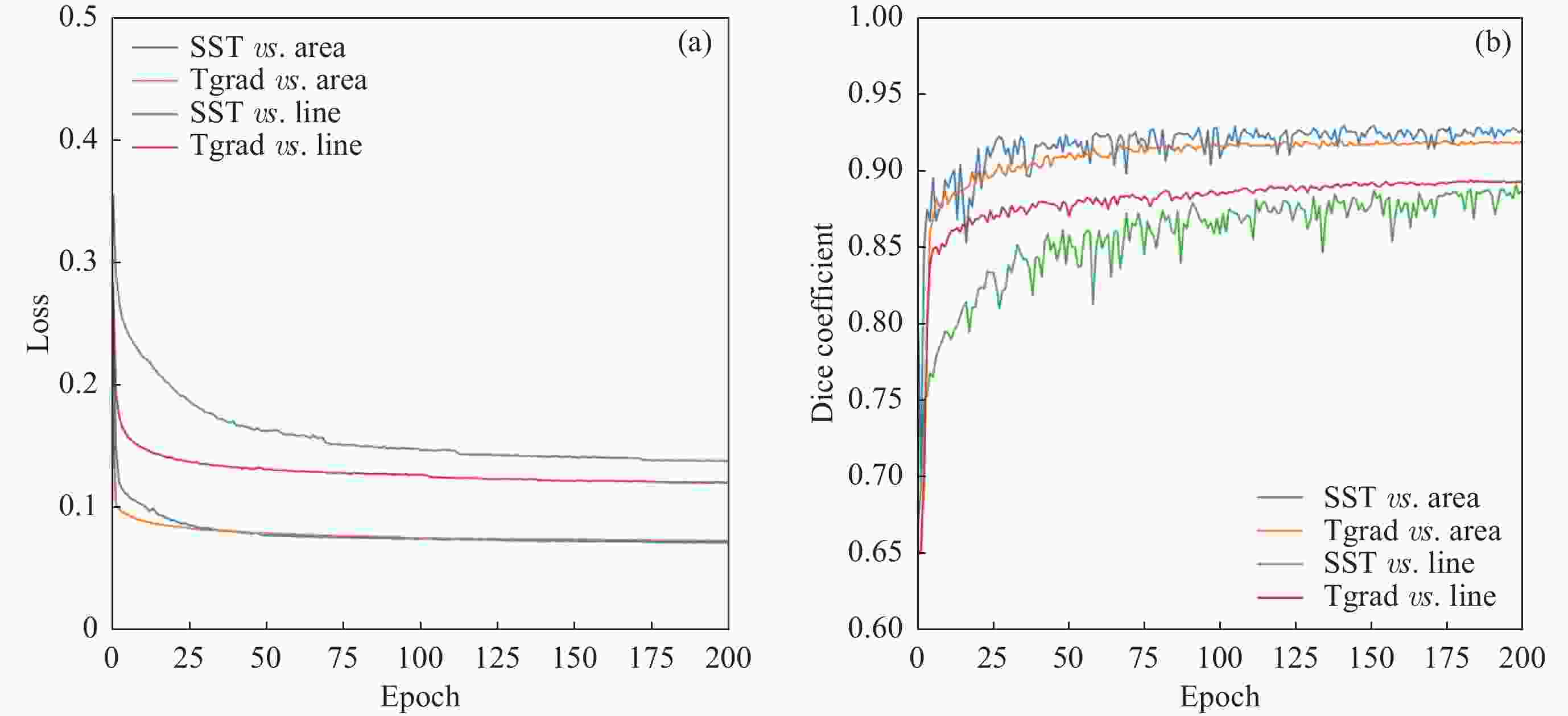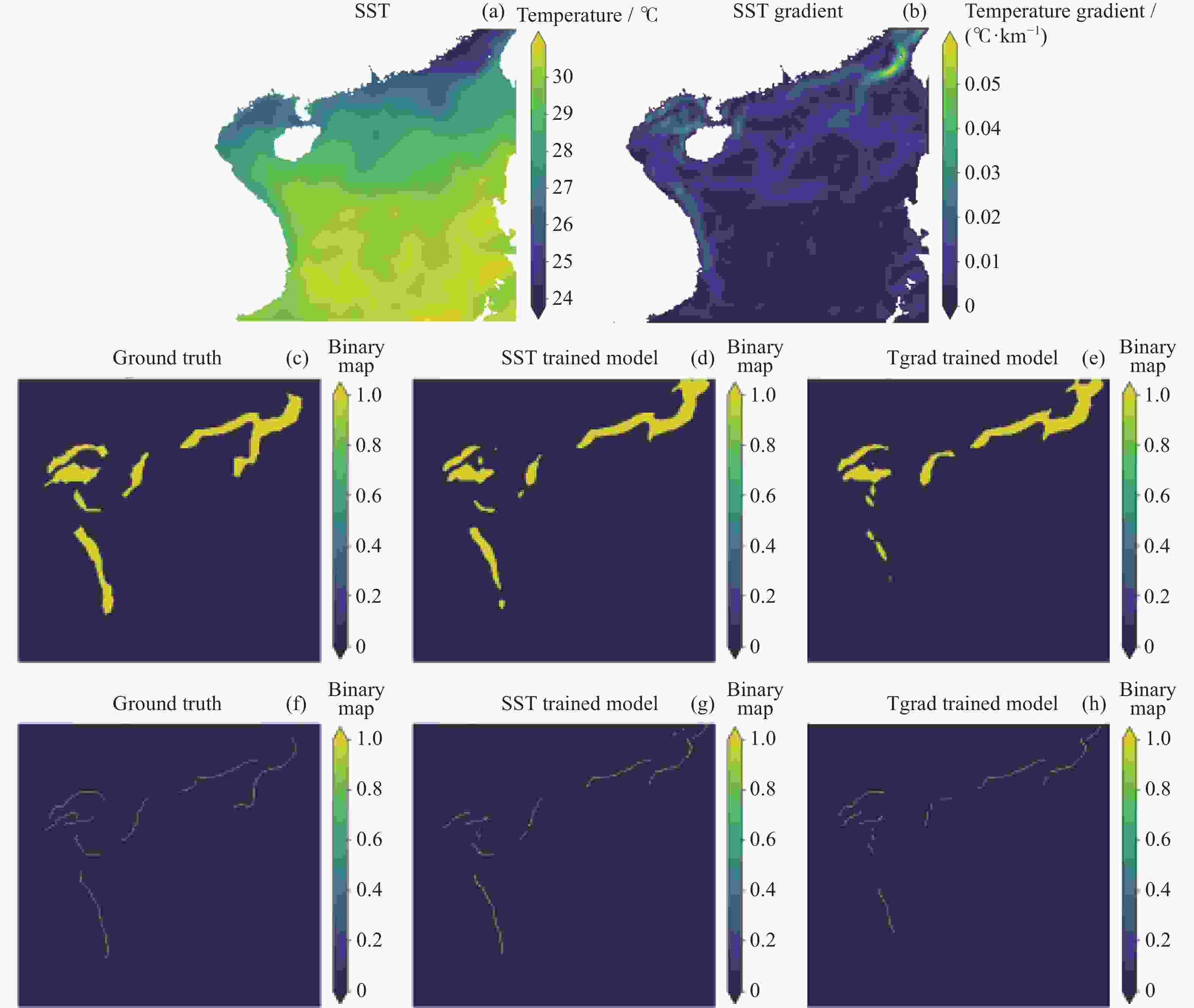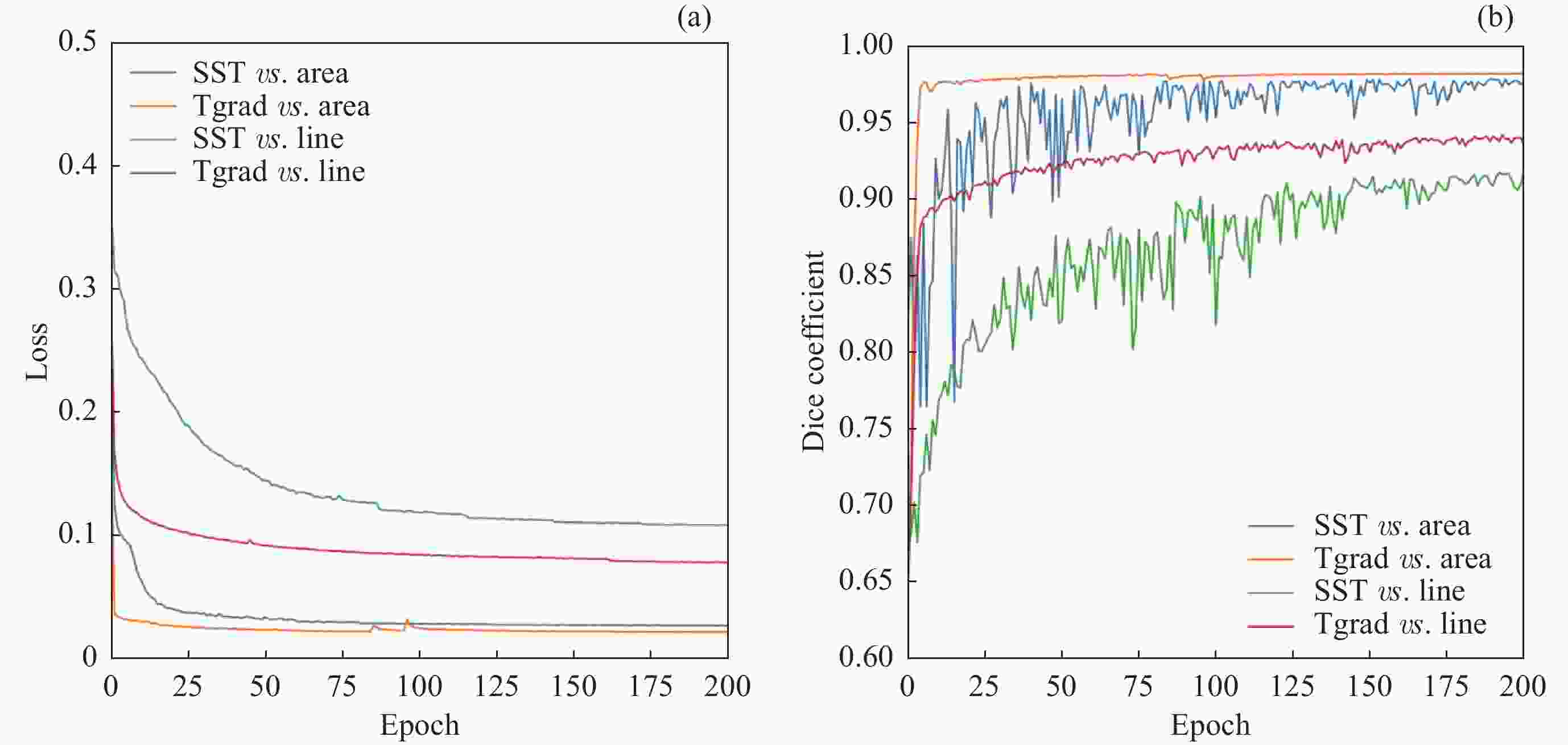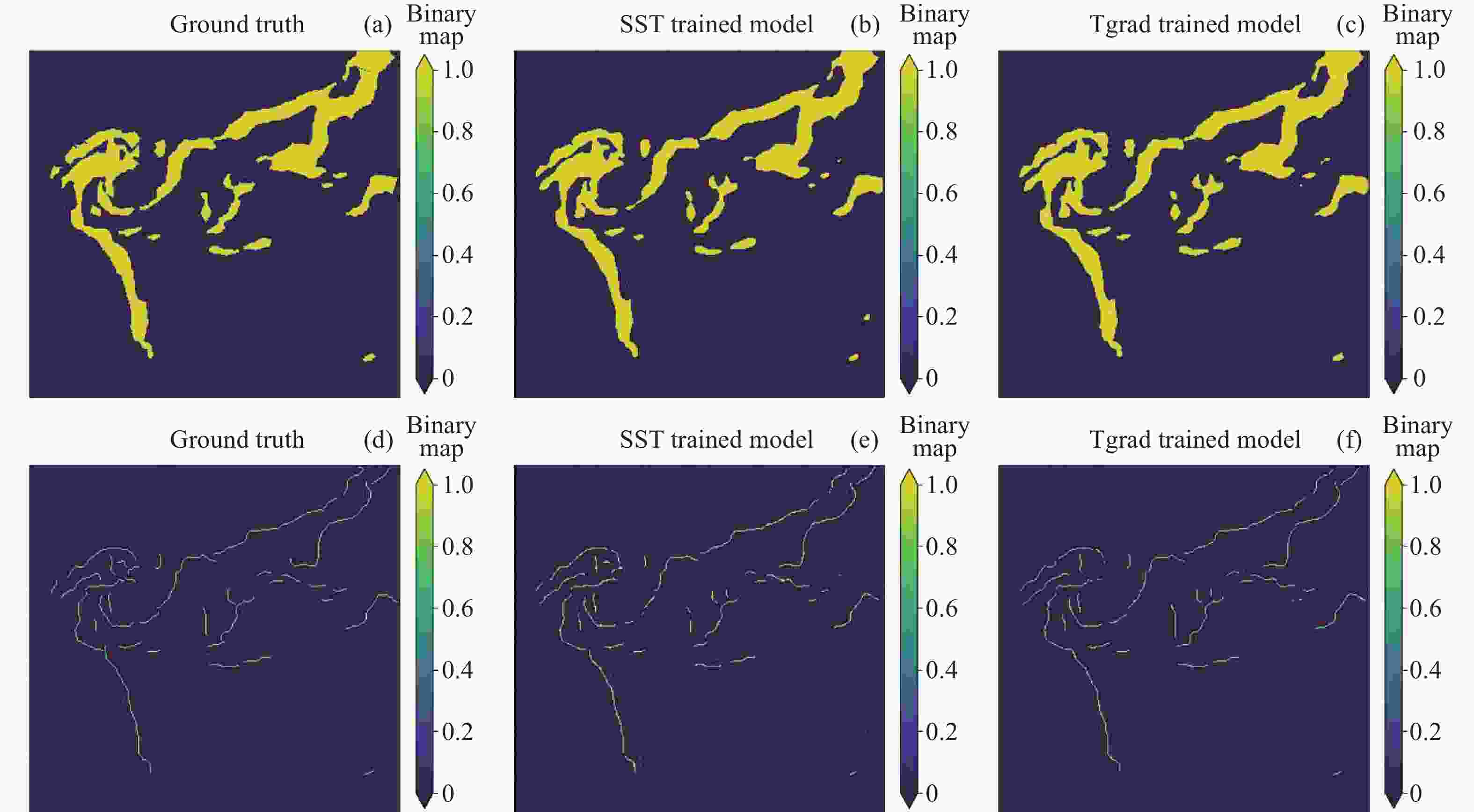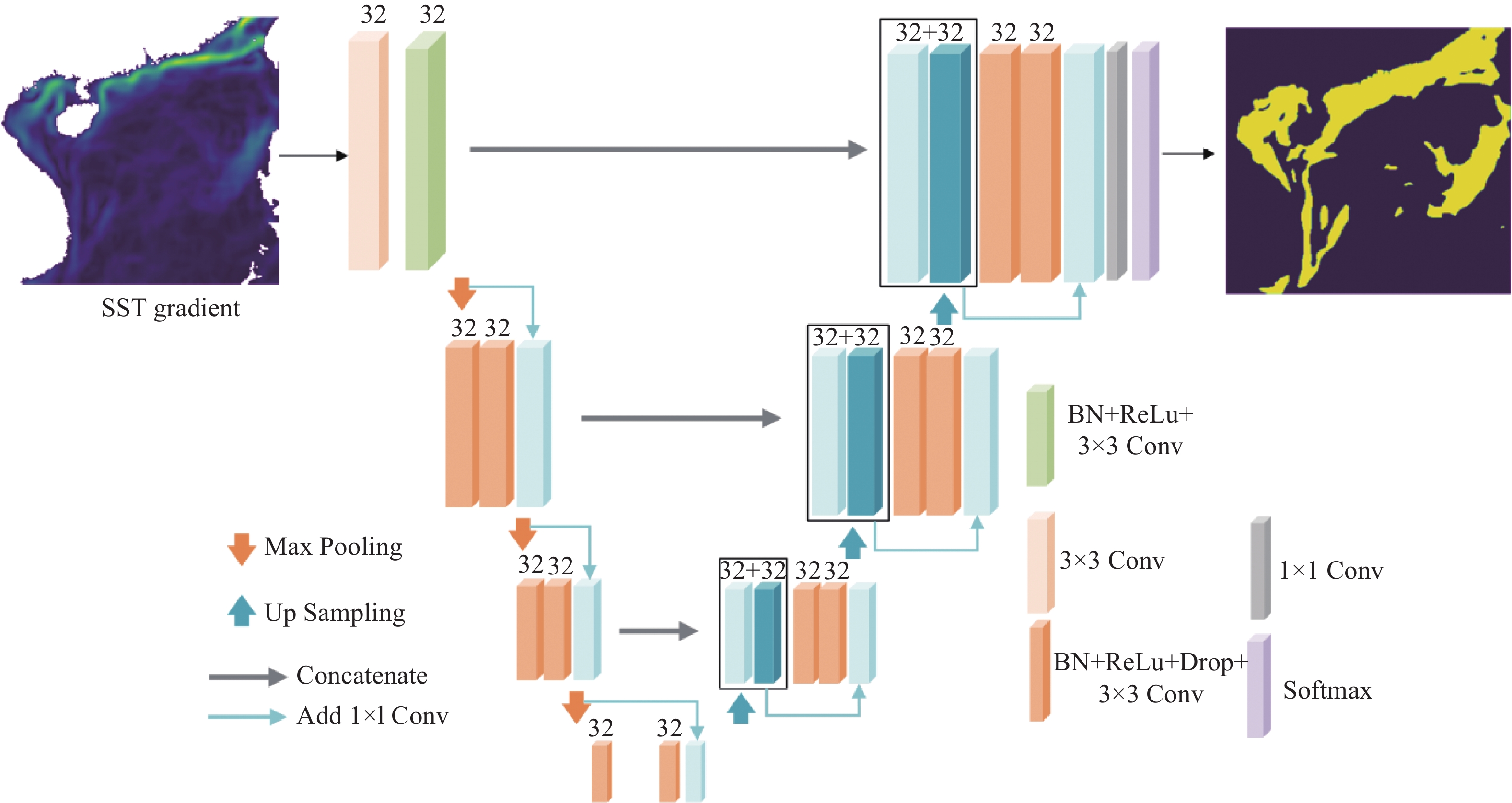Oceanic Front Detection Model Based on U-Net Network
-
摘要: 海洋锋作为海洋中两种不同性质的水体之间的边界,对渔业和海洋环境保护等许多领域有重要影响,如何快速准确实现海洋锋的自动检测和识别对于海洋监测和预报具有重要的科学意义。将深度学习图像分割网络与提取锋面特征的方法相结合,利用基于U-Net架构的实例分割模型,分别建立海洋锋区和锋面中心线的智能检测模型,同时在编解码过程中采用残差学习单元对模型特征提取网络进行改进。研究结果表明,锋面智能检测模型能够准确提取先前锋面检测算法所识别的锋区和锋面中心线特征,Dice系数分别达到了0.92和0.97,达到了很好的检测效果。同时,利用不同锋面阈值得到的样本数据对模型进行训练,比较结果表明,降低样本集阈值之后模型精度有了显著的提升。Abstract: As a boundary of two water masses with different properties, oceanic fronts have important influences on many fields such as fishery, marine military and environmental protection. How to quickly and accurately implement automatic detection and identification of ocean front is of great scientific significance for ocean monitoring and forecasting. In this paper, the deep learning image segmentation network is combined with the method of extracting frontal features, and the detection models of frontal area and frontal line are established by using U-Net architecture. Meanwhile, the residual unit is used to improve the feature extraction network in the processes of encoding and decoding. The results show that the deep learning frontal detection model can accurately extract the features of frontal area and frontal line. The Dice coefficients reach 0.92 and 0.97 respectively, achieving a good detection performance. In this paper, the model is trained by the sample data of different frontal thresholds. The comparison results show that the accuracy of model is significantly improved after the threshold of sample set is reduced.
-
Key words:
- Oceanic fronts /
- Sea surface temperature /
- Deep learning /
- U-Net
-
图 4 (a)(b)测试集2017年第139天的SST及其梯度分布。(c)~(e)为锋区检测模型结果(0表示背景,1表示锋面),(f)~(h)为锋面中心线检测模型结果(0表示背景,1表示锋面)
Figure 4. (a) (b) SST in Day 139 in 2017 and SST gradient. (c)~(e) are frontal area model results (0 expresses backgroud, 1 expresses front); (f)~(h) are frontal line model results (0 expresses backgroud, 1 expresses front)
表 1 4种模型测试集的评价指标
Table 1. Evaluation metrics of four models in the test set
Model name Categorical accuracy Weighted Dice SST vs. area 0.9801 0.9238 Tgrad vs. area 0.9785 0.9182 SST vs. line 0.9973 0.8893 Tgrad vs. line 0.9966 0.8923 表 2 exp_bases实验中4种模型测试集的评价指标
Table 2. Evaluation metrics of four models in the test set of exp_base
Model name ctrl exp_base SST vs. area 0.9238 0.9791 Tgrad vs. area 0.9182 0.9831 SST vs. line 0.8893 0.9219 Tgrad vs. line 0.8923 0.9468 -
[1] BELKIN I M. Remote sensing of ocean fronts in marine ecology and fisheries[J]. Remote Sensing, 2021, 13(5): 883 doi: 10.3390/rs13050883 [2] 任诗鹤, 王辉, 刘娜. 中国近海海洋锋和锋面预报研究进展[J]. 地球科学进展, 2015, 30(5): 552-563 doi: 10.11867/j.issn.1001-8166.2015.05.0552REN Shihe, WANG Hui, LIU Na. Review of ocean front in Chinese marginal seas and frontal forecasting[J]. Advances in Earth Science, 2015, 30(5): 552-563 doi: 10.11867/j.issn.1001-8166.2015.05.0552 [3] XING Q W, YU H Q, LIU Y, et al. Application of a fish habitat model considering mesoscale oceanographic features in evaluating climatic impact on distribution and abundance of Pacific saury ( Cololabis saira)[J]. Progress in Oceanography, 2022, 201: 102743 doi: 10.1016/j.pocean.2022.102743 [4] WOODSON C B, LITVIN S Y. Ocean fronts drive marine fishery production and biogeochemical cycling[J]. Proceedings of the National Academy of Sciences of the United States of America, 2015, 112(6): 1710-1715 [5] BURNETT W, HARPER S, PRELLER R, et al. Overview of operational ocean forecasting in the US Navy: Past, present, and future[J]. Oceanography, 2014, 27(3): 24-31 doi: 10.5670/oceanog.2014.65 [6] BELKIN I M, CORNILLON P C, SHERMAN K. Fronts in large marine ecosystems[J]. Progress in Oceanography, 2009, 81(1/2/3/4): 223-236 [7] ORAM J J, MCWILLIAMS J C, STOLZENBACH K D. Gradient-based edge detection and feature classification of sea-surface images of the Southern California Bight[J]. Remote Sensing of Environment, 2008, 112(5): 2397-2415 doi: 10.1016/j.rse.2007.11.010 [8] REN S H, ZHU X M, DREVILLON M, et al. Detection of SST fronts from a high-resolution model and its preliminary results in the South China Sea[J]. Journal of Atmospheric and Oceanic Technology, 2021, 38(2): 387-403 doi: 10.1175/JTECH-D-20-0118.1 [9] CAYULA J F, CORNILLON P. Edge detection algorithm for SST images[J]. Journal of Atmospheric and Oceanic Technology, 1992, 9(1): 67-80 doi: 10.1175/1520-0426(1992)009<0067:EDAFSI>2.0.CO;2 [10] XING Q W, YU H Q, WANG H, et al. An improved algorithm for detecting mesoscale ocean fronts from satellite observations: Detailed mapping of persistent fronts around the China Seas and their long-term trends[J]. Remote Sensing of Environment, 2023, 294: 113627 doi: 10.1016/j.rse.2023.113627 [11] CANNY J. A computational approach to edge detection[J]. IEEE Transactions on Pattern Analysis and Machine Intelligence, 1986, PAMI-8(6): 679-698 doi: 10.1109/TPAMI.1986.4767851 [12] 国家海洋环境预报中心. 海洋温度锋的特征参数提取方法和装置: 中国, 113111785A[P]. 2021-07-13National Marine Environmental Forecasting Center. Method and device for extracting characteristic parameters of ocean thermal fronts: CN, 113111785A[P]. 2021-07-13 [13] XIE C, GUO H, DONG J Y. LSENet: Location and seasonality enhanced network for multiclass ocean front detection[J]. IEEE Transactions on Geoscience and Remote Sensing, 2022, 60: 4207609 [14] SUN X, WANG C G, DONG J Y, et al. A multiscale deep framework for ocean fronts detection and fine-grained location[J]. IEEE Geoscience and Remote Sensing Letters, 2019, 16(2): 178-182 doi: 10.1109/LGRS.2018.2869647 [15] 中国海洋大学. 海洋锋面的精细化识别方法、系统、设备、终端及应用: 中国, 112508079A[P]. 2021-03-16Ocean University of China. Method, system, equipment, terminal and application of fine detection of oceanic fronts: CN, 112508079A[P]. 2021-03-16 [16] FELT V, KACKER S, KUSTERS J, et al. Fast ocean front detection using deep learning edge detection models[J]. IEEE Transactions on Geoscience and Remote Sensing, 2023, 61: 4204812 [17] LIMA E, SUN X, YANG Y T, et al. Application of deep convolutional neural networks for ocean front recognition[J]. Journal of Applied Remote Sensing, 2017, 11(4): 042610 [18] LIMA E, SUN X, DONG J Y, et al. Learning and transferring convolutional neural network knowledge to ocean front recognition[J]. IEEE Geoscience and Remote Sensing Letters, 2017, 14(3): 354-358 doi: 10.1109/LGRS.2016.2643000 [19] LI Q Y, ZHONG G Q, XIE C, et al. Weak edge identification network for ocean front detection[J]. IEEE Geoscience and Remote Sensing Letters, 2022, 19: 1501905 [20] 曹维东, 解翠, 韩冰, 等. 融合深度学习的自动化海洋锋精细识别[J]. 计算机工程, 2020, 46(10): 266-274 doi: 10.19678/j.issn.1000-3428.0055985CAO Weidong, XIE Cui, HAN Bing, et al. Automatic fine recognition of ocean front fused with deep learning[J]. Computer Engineering, 2020, 46(10): 266-274 doi: 10.19678/j.issn.1000-3428.0055985 [21] LI Y D, LIANG J H, DA H R, et al. A deep learning method for ocean front extraction in remote sensing imagery[J]. IEEE Geoscience and Remote Sensing Letters, 2022, 19: 1502305 [22] LGUENSAT R, SUN M, FABLET R, et al. EddyNet: A deep neural network for pixel-wise classification of oceanic eddies[C]//Proceeding of IGARSS 2018-2018 IEEE International Geoscience and Remote Sensing Symposium. Valencia, Spain: IEEE, 2018: 1764-1767 [23] DONLON C J, MARTIN M, STARK J, et al. The Operational Sea Surface Temperature and Sea Ice Analysis (OSTIA) system[J]. Remote Sensing of Environment, 2012, 116: 140-158 doi: 10.1016/j.rse.2010.10.017 -
-





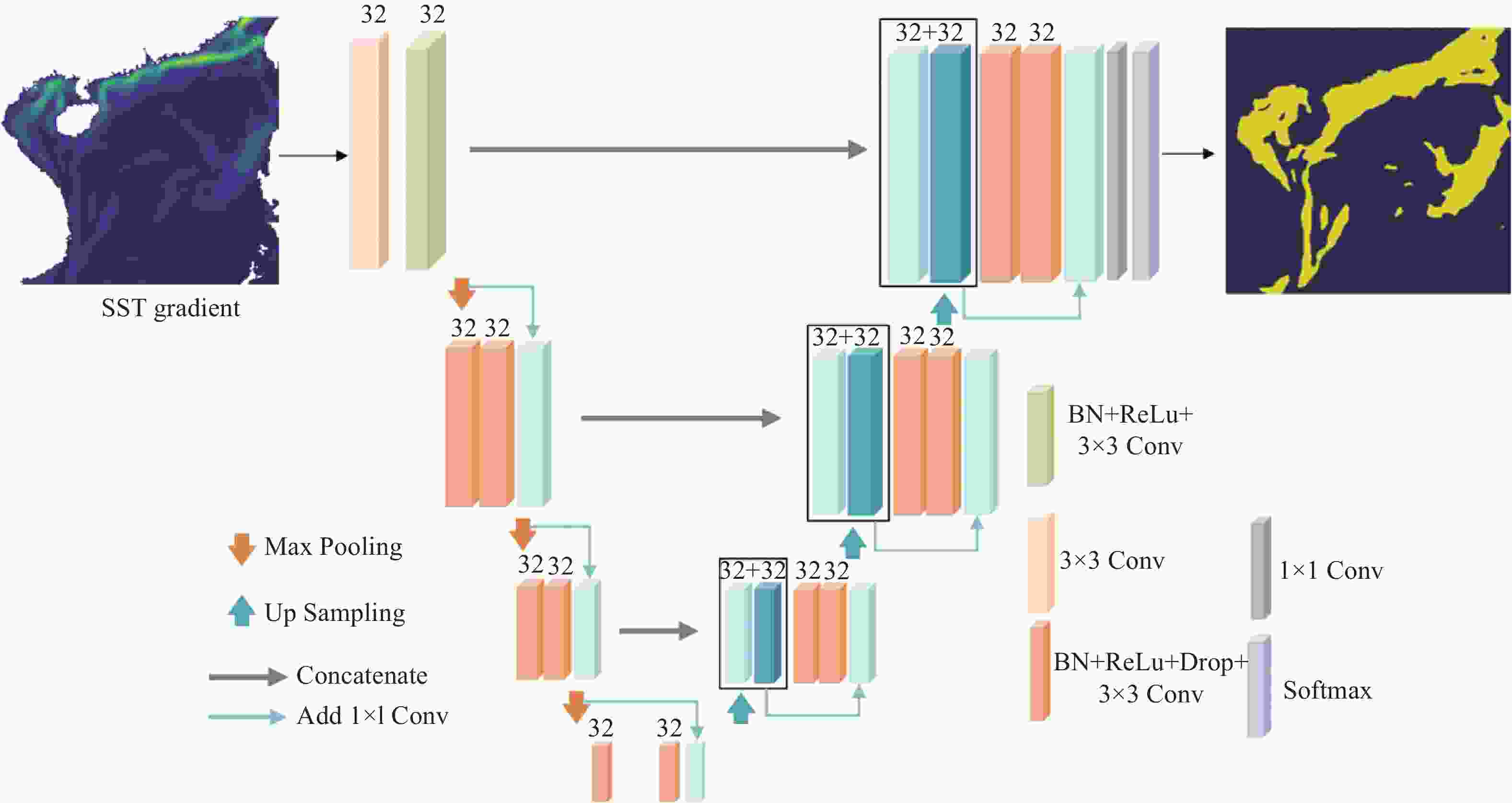
 下载:
下载:
